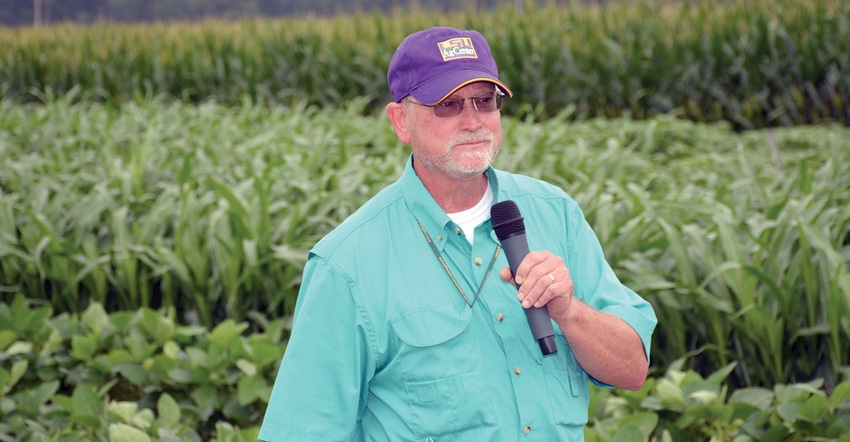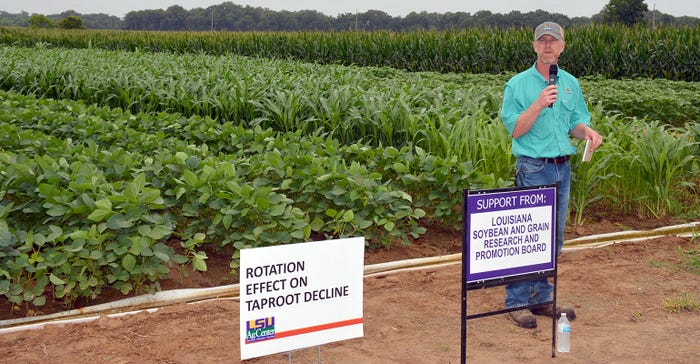
Louisiana farmers may be stressing a bit over drought conditions that some are calling “abnormal,” but one upside is they’re also experiencing the least amount of disease pressure they’ve witnessed in years.
Boyd Padgett, LSU Extension pathologist who works mostly the central and southern parts of the state, says Louisiana farmers typically deal with a significant amount of plant diseases. “But this is the lightest disease pressure I’ve seen since I’ve been working here, and that’s close to 30 years,” he said at the recent AgCenter Expo in Winnsboro, La.
“More than likely, low disease pressure is because of the hot dry weather. However, over the last several days, perhaps over the last week or two, we’ve begun to receive some moisture, which will undoubtedly fuel epidemics of disease in our corn and soybeans.”
It may not matter. He says corn is “pretty far along, so I’m not sure it’s going to be affected by disease.”
He still recommends producers stay vigilant. “First, I’d have them check variety resistance. With soybeans, we have resistant varieties. Frogeye, for instance, is a problem, but we do have genetic resistance, and that’s going to be the No. 1 way to manage disease, if a resistant variety is available. It doesn’t cost growers any time or any extra money to use resistant varieties.”
He encourages growers to look into the leaf canopy, where disease is likely to start because wetness periods are longer and conditions are conducive to disease development. “If you do have a susceptible variety, you’ll have to reassess, look at growth stage, yield potential, and then decide whether or not to use a fungicide — if we have an effective fungicide available.”
Fungicide resistance
Padgett says in the southern part of the state, some pathogens, rhizoctonia specifically, which infect rice as well as soybeans, are resistant to some of the fungicides. “Just be aware of that. Resistance will determine what type of fungicide you use. Some that were once effective are not going to be very effective anymore.”
Padgett says an automatic fungicide application in corn is not recommended. “It will be a field-by-field situation, and I would say that our corn crop is pretty far along because of this heat, and I would add that very few fields would benefit from a fungicide application. However, we still need to make a field-by-field assessment.”
Trey Price, LSU AgCenter research pathologist, works primarily the northern part of the state and into central Louisiana. He agrees with Padgett that the disease situation this season has been light, especially with corn. “We’re hardly seeing anything. We are getting some pictures in from consultants showing foliar diseases with minor severity in the lower part of the canopy. They do not call for any action with a fungicide spray. Overall, it’s been light, which is good for our growers because they are spending a chunk of money on irrigation.”

Trey Price, LSU AgCenter research pathologist, says disease pressure in the northern part of Louisiana has been one of the lightest he’s seen.
Soybean disease pressure is also very light. “I’m having trouble finding disease pressure in the northern part of the state,” Price says. He can’t find disease in his research plots. “I hope that changes for our research, but I hope it stays the same for our farmers.”
Early cotton had some problems. “We had a few seedling disease outbreaks in cotton that some farmers planted a little too early in cold wet conditions,” Price says.
With warm weather at the end of April, “cotton took off and weather has been conducive to cotton development — hot and dry. Producers are beginning to irrigate cotton.” He’s not seeing any serious foliar diseases. “But if it starts raining in July or the middle of August, we’re going to have problems with target spot. We hope the weather will be better for cotton growers this year.”
For now, he says cotton, corn and soybeans would benefit from a good rain. “Some people have been getting showers, but a general overall rain across the state would be welcome.”
Note: AgCenter sources report the area received about one-third inch of rain Tuesday afternoon and evening.
About the Author(s)
You May Also Like






